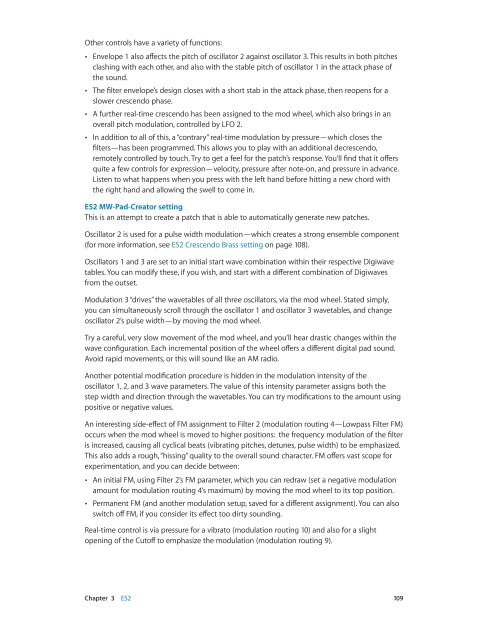Apple MainStage 3 Instruments - MainStage 3 Instruments
Apple MainStage 3 Instruments - MainStage 3 Instruments
Apple MainStage 3 Instruments - MainStage 3 Instruments
Create successful ePaper yourself
Turn your PDF publications into a flip-book with our unique Google optimized e-Paper software.
Other controls have a variety of functions:<br />
••<br />
Envelope 1 also affects the pitch of oscillator 2 against oscillator 3. This results in both pitches<br />
clashing with each other, and also with the stable pitch of oscillator 1 in the attack phase of<br />
the sound.<br />
••<br />
The filter envelope’s design closes with a short stab in the attack phase, then reopens for a<br />
slower crescendo phase.<br />
••<br />
A further real-time crescendo has been assigned to the mod wheel, which also brings in an<br />
overall pitch modulation, controlled by LFO 2.<br />
••<br />
In addition to all of this, a “contrary” real-time modulation by pressure—which closes the<br />
filters—has been programmed. This allows you to play with an additional decrescendo,<br />
remotely controlled by touch. Try to get a feel for the patch’s response. You’ll find that it offers<br />
quite a few controls for expression—velocity, pressure after note-on, and pressure in advance.<br />
Listen to what happens when you press with the left hand before hitting a new chord with<br />
the right hand and allowing the swell to come in.<br />
ES2 MW-Pad-Creator setting<br />
This is an attempt to create a patch that is able to automatically generate new patches.<br />
Oscillator 2 is used for a pulse width modulation—which creates a strong ensemble component<br />
(for more information, see ES2 Crescendo Brass setting on page 108).<br />
Oscillators 1 and 3 are set to an initial start wave combination within their respective Digiwave<br />
tables. You can modify these, if you wish, and start with a different combination of Digiwaves<br />
from the outset.<br />
Modulation 3 “drives” the wavetables of all three oscillators, via the mod wheel. Stated simply,<br />
you can simultaneously scroll through the oscillator 1 and oscillator 3 wavetables, and change<br />
oscillator 2’s pulse width—by moving the mod wheel.<br />
Try a careful, very slow movement of the mod wheel, and you’ll hear drastic changes within the<br />
wave configuration. Each incremental position of the wheel offers a different digital pad sound.<br />
Avoid rapid movements, or this will sound like an AM radio.<br />
Another potential modification procedure is hidden in the modulation intensity of the<br />
oscillator 1, 2, and 3 wave parameters. The value of this intensity parameter assigns both the<br />
step width and direction through the wavetables. You can try modifications to the amount using<br />
positive or negative values.<br />
An interesting side-effect of FM assignment to Filter 2 (modulation routing 4—Lowpass Filter FM)<br />
occurs when the mod wheel is moved to higher positions: the frequency modulation of the filter<br />
is increased, causing all cyclical beats (vibrating pitches, detunes, pulse width) to be emphasized.<br />
This also adds a rough, “hissing” quality to the overall sound character. FM offers vast scope for<br />
experimentation, and you can decide between:<br />
••<br />
An initial FM, using Filter 2’s FM parameter, which you can redraw (set a negative modulation<br />
amount for modulation routing 4’s maximum) by moving the mod wheel to its top position.<br />
••<br />
Permanent FM (and another modulation setup, saved for a different assignment). You can also<br />
switch off FM, if you consider its effect too dirty sounding.<br />
Real-time control is via pressure for a vibrato (modulation routing 10) and also for a slight<br />
opening of the Cutoff to emphasize the modulation (modulation routing 9).<br />
Chapter 3 ES2 109
















